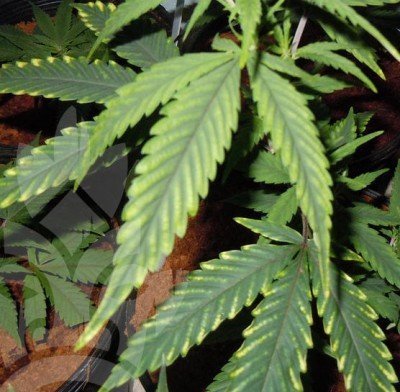Don't have an account?
Register NowYou have to add to cart at least 5 bottles or any program to make checkout.
- BlogGrow Tip: How To Spot A Magnesium Deficiency
Grow Tip: How To Spot A Magnesium Deficiency
Published: May 11th, 2016
Categories:
Cannabis Cultivation
Spotting and dealing with a magnesium deficiency can be quite tricky, so make sure you know what to do – and minimize the risk to your plants.
It’s not all just about NPK. Cannabis needs a whole array of different nutrients to really thrive, and being deficient in any one of them can have dire consequences for your green beauties. One such nutrient is magnesium. Magnesium is a secondary macro nutrient that tends to take a back seat when compared to the primary nutrients cannabis needs.
This is down to the fact that your plants will not need as much of it as the more famous NPK group, and there is normally a good reserve of it in most soil. However, just because your cannabis doesn’t need as much of it, doesn’t mean it doesn’t need it at all. Magnesium is an essential part of vein maintenance and leaf production; it is also used in the creation of chlorophyll, and aids the absorption of phosphorous (one of the primary nutrients) by the roots.
A deficiency can occur in all growing mediums and hydroponic set ups, although it is much rarer in an outdoor situation – so keep an eye out for it.
Recognizing A Magnesium Deficiency
The symptoms of a magnesium deficiency can easily be misdiagnosed and mistaken for a deficiency of one of the major nutrients, or even nutrient burn. For this reason it is very important to know exactly what to look for. If left unattended, a magnesium deficiency can quickly spiral out of control.
When a magnesium deficiency occurs, your cannabis will pull all the magnesium out of the old leaves and reroute it to the newer leaves. This causes the symptoms of a magnesium deficiency to first become visible in the lower leaves, causing yellowing and chlorosis – especially around the margins of the leaves. The leaves will start to curl inwards and the edges will feel dry and crispy, eventually causing them to die. You can tell this apart from nutrient burn, as nutrient burn will not cause discoloration along the margins of each ‘segment’ of leaf.
Fixing A Magnesium Deficiency
The good news is a magnesium deficiency is super easy to fix once you have spotted it. The most straight forward way is to simply get hold of a marijuana soil booster. Most of these have a healthy amount of magnesium in them, and are easy to incorporate into a feeding schedule.
Another option is to use Epsom salts. These are potentially easier for those growing with hydroponic systems, as the salts are easily dissolved in water. To use Epsom salts, dilute 5 litres of water with one teaspoon of salt. Then use a quarter of the amount for each subsequent treatment.
If you are a soil grower, then consider using organic dolomite lime. This is a great source of both magnesium and calcium, and is easy to mix into your soil. Ideally you want to use 7 teaspoons per 5 litres of soil. The finer the dolomite lime is, the easier it will be utilised by your cannabis.
What About pH?
If you want your magnesium to be absorbed properly, you are going to have to make sure the pH of your growing medium is correct.
In soil, magnesium is best absorbed between 6.0-7.0 pH.
In a hydro set up, magnesium is best absorbed between 6.0-6.5 pH.
Recovering From The Deficiency
Now that you have your magnesium deficiency sorted, your cannabis should be back on track. It is worth noting that the leaves damaged by the deficiency are unlikely to recover, and will stay yellowed and damaged in appearance. However, you will know that the ordeal is over when the yellowing stops spreading to new leaves, preventing further damage and despair. Further yellowing can still occur in damaged leaves. It is best not to remove any leaves damaged leaves until you are certain that the problem has passed.
So, with this knowledge in hand, you should be well prepared to identify the signs, and know how to rescue your crop from a potentially fatal deficiency. Remember, the best treatment is prevention – hopefully if you look after your cannabis well, you will never have to use this info. Good luck, and stay safe!





